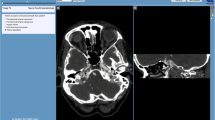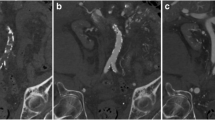Abstract
Objective
Assess the use of a volumetric simulation tool for the evaluation of radiology resident MR and CT interpretation skills.
Material and methods
Forty-three participants were evaluated with a software allowing the visualisation of multiple volumetric image series. There were 7 medical students, 28 residents and 8 senior radiologists among the participants. Residents were divided into two sub-groups (novice and advanced). The test was composed of 15 exercises on general radiology and lasted 45 min. Participants answered a questionnaire on their experience with the test using a 5-point Likert scale. This study was approved by the dean of the medical school and did not require ethics committee approval.
Results
The reliability of the test was good with a Cronbach alpha value of 0.9. Test scores were significantly different in all sub-groups studies (p < 0.0225). The relation between test scores and the year of residency was logarithmic (R2 = 0.974). Participants agreed that the test reflected their radiological practice (3.9 ± 0.9 on a 5-point scale) and was better than the conventional evaluation methods (4.6 ± 0.5 on a 5-point scale).
Conclusion
This software provides a high quality evaluation tool for the assessment of the interpretation skills in radiology residents.
Key Points
• This tool allows volumetric image analysis of MR and CT studies.
• A high reliability test could be created with this tool.
• Test scores were strongly associated with the examinee expertise level.
• Examinees positively evaluated the authenticity and usability of this tool.



Similar content being viewed by others
References
McDonald RJ, Schwartz KM, Eckel LJ et al (2015) The effects of changes in utilization and technological advancements of cross-sectional imaging on radiologist workload. Acad Radiol. doi:10.1016/j.acra.2015.05.007
Runge VM (2013) Current technological advances in magnetic resonance with critical impact for clinical diagnosis and therapy. Investig Radiol 48:869–877
Rengier F, Häfner MF, Unterhinninghofen R et al (2013) Integration of interactive three-dimensional image post-processing software into undergraduate radiology education effectively improves diagnostic skills and visual-spatial ability. Eur J Radiol 82:1366–1371
Chetlen AL, Mendiratta-Lala M, Probyn L et al (2015) Conventional medical education and the history of simulation in radiology. Acad Radiol. doi:10.1016/j.acra.2015.07.003
van der Gijp A, Ravesloot CJ, van der Schaaf MF et al (2015) Volumetric and two-dimensional image interpretation show different cognitive processes in learners. Acad Radiol 22:632–639
Ravesloot CJ, van der Gijp A, van der Schaaf MF et al (2015) Support for external validity of radiological anatomy tests using volumetric images. Acad Radiol 22:640–645
Ravesloot CJ, van der Schaaf MF, van Schaik JPJ et al (2015) Volumetric CT-images improve testing of radiological image interpretation skills. Eur J Radiol 84:856–861
Diaz I, Schmidt S, Verdun FR, Bochud FO (2015) Eye-tracking of nodule detection in lung CT volumetric data. Med Phys 42:2925
Bruno MA, Walker EA, Abujudeh HH (2015) Understanding and confronting our mistakes: the epidemiology of error in radiology and strategies for error reduction. Radiographics 35:1668–1676
Rozenshtein A, Mullins ME, Deitte LA et al (2015) “What program directors think” II: results of the 2013 and 2014 Annual Surveys of the Association of Program Directors in Radiology. Acad Radiol 22:787–793
Seagull FJ, Bailey JE, Trout A et al (2014) Residents’ ability to interpret radiology images: development and improvement of an assessment tool. Acad Radiol 21:909–915
Grayev A, Ziemlewicz T, Kim D et al (2013) Residents’ perception of a novel end-of-rotation evaluation method. Acad Radiol 20:312–319
Blondon K, Wipfli R, Lovis C (2015) Use of eye-tracking technology in clinical reasoning: a systematic review. Stud Health Technol Inform 210:90–94
Phelps A, Naeger DM, MacKenzie J, Qayyum A (2011) Educating radiology residents in the new era: implementation and evaluation of online end-of-rotation examinations. Acad Radiol 18:1442–1446
Tubbs RJ, Murphy B, Mainiero MB et al (2009) High-fidelity medical simulation as an assessment tool for radiology residents’ acute contrast reaction management skills. J Am Coll Radiol 6:582–587
Oris E, Verstraete K, Valcke M, ESR Working Group on Undergraduate Education (2012) Results of a survey by the European Society of Radiology (ESR): undergraduate radiology education in Europe-influences of a modern teaching approach. Insights Imaging 3:121–130
Di Marco L, Anderson MB (2016) The new Interventional Radiology/Diagnostic Radiology dual certificate: “higher standards, better education”. Insights Imaging. doi:10.1007/s13244-015-0450-9
Semelka RC, Elias J (2013) Health care reform in radiology. John Wiley & Sons
Mallett S, Phillips P, Fanshawe TR et al (2014) Tracking eye gaze during interpretation of endoluminal three-dimensional CT colonography: visual perception of experienced and inexperienced readers. Radiology 273:783–792
Rubin GD, Roos JE, Tall M et al (2015) Characterizing search, recognition, and decision in the detection of lung nodules on CT scans: elucidation with eye tracking. Radiology 274:276–286
Sasson NJ, Elison JT (2012) Eye tracking young children with autism. J Vis Exp. doi:10.3791/3675
Acknowledgments
The scientific guarantor of this publication is Prof. Alain Blum. The authors of this manuscript declare no relationships with any companies, whose products or services may be related to the subject matter of the article. The authors state that this work has not received any funding. Dr. Gabriela Hossu kindly provided statistical advice for this manuscript. Institutional Review Board approval was not required because this study was not performed on patients but radiology residents. This study was approved by the Dean of the school of medicine in which this work was performed.
Written informed consent was obtained from all subjects (patients) in this study. No study subjects or cohorts have been previously reported. Methodology: prospective, observational, performed at one institution.
Author information
Authors and Affiliations
Corresponding author
Appendix
Appendix
Rights and permissions
About this article
Cite this article
Gondim Teixeira, P.A., Cendre, R., Hossu, G. et al. Radiology resident MR and CT image analysis skill assessment using an interactive volumetric simulation tool – the RadioLOG project. Eur Radiol 27, 878–887 (2017). https://doi.org/10.1007/s00330-016-4384-5
Received:
Revised:
Accepted:
Published:
Issue Date:
DOI: https://doi.org/10.1007/s00330-016-4384-5




